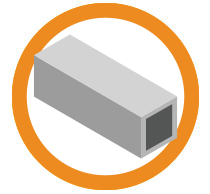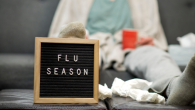
Particulate matter (PM), is a term that describes microscopic solid particles and liquid droplets, which are suspended in air. PM2.5 are particles or droplets that are two and a half microns or less in width.

One micron is equivalent to one one-thousandth of a millimetre [1 micron (1μ) = 1/1000 mm] or 1 micron (micrometer) = 1/1,000,000 of a metre. To put this in context, the particulates are 25 to 100 times thinner than a human hair, and therefore are capable of causing severe risk to our health.
Particulate matter can be made up of a variety of components including nitrates, sulfates, organic chemicals, metals, soil or dust particles, and allergens (such as fragments of pollen or mould spores).
Particle pollution mainly comes from motor vehicles, wood burning heaters and industry. During bushfires or dust storms, particle pollution can reach extremely high concentrations.
On average, humans take around 20,000 breaths per day. Everything that we inhale travels through our body via the respiratory tract, entering our lungs and eventually our bloodstream.
Since PM2.5 are so tiny and weightless, they can stay longer in the air than larger particles. Thus increasing the chance of breathing them in. And, because of their miniscule size, they are able to bypass the nose and throat and penetrate deep into the lungs and enter the respiratory and circulatory systems where they stay.
Health Problems Caused by PM2.5
Exposure to PM2.5 has a multitude of short and long term health impacts. Short term (hours to days) includes irritation in the eyes, nose and throat, coughing, sneezing, shortness of breath, worsening asthma, and chronic bronchitis.
A prolonged exposure (many years) to PM2.5 can cause permanent respiratory problems such as reduced lung function, development of cardiovascular/respiratory diseases, and reduced life expectancy. This is serious stuff!
The World Health Organisation has a great explainer on the health risks air pollution:
How to Measure PM2.5 Levels
Levels of PM2.5 are measured in micrograms per cubic meter (μg/m3). On a very clear and non-hazy day, the PM2.5 concentration can be as low as 5 μg/m3 or below. The 24-hour concentration of PM2.5 is considered unhealthy when it rises above 35.4 μg/m3. The award-winning QP Pro Air Quality Monitor is the perfect tool to detect not only PM2.5, but also dangerous gases (tVOC), CO2, temperature, and humidity. Additionally, it provides information on the outdoor environment, including weather forecasts, AQI, and UV index. The QP Pro allows you to monitor 24/7 the air in your home or business so you never breathe dangerous air again.
How to Protect Yourself Against PM2.5
It is not all doom and gloom. Take these steps to reduce exposure and protect your health:
- If you are aware of particularly bad levels of pollutants, it is best to stay indoors, if possible. Close all windows and openings that allow polluted air to enter
- Turn on an air purifier that is equipped with a HEPA filter. Only a HEPA filter can effectively remove fine particles from the air. The filter used in the Blast and Blast Mini are made of PP+PET materials that have an effectiveness of 99.95% when filtering PM2.5. It is a H13 grade filter, which is more effective
- When most or all windows are closed, do not burn candles, incense or operate devices that emit smoke. This will prevent harmful particles and gas (such as carbon monoxide) from building up.
- If you are driving get a real air purifier for your car, which comes with a HEPA filter. Normal car filters are not even effective at proper traffic exhaust removal, let alone microscopic particles. The SmartAir QT3 Portable Air Purifier with HEPA Filter – Travel Version is the perfect solution https://www.bsthealth.com.au/smartair-qt3-portable-air-purifier-with-hepa-filter-travel-version.html it includes a built-in battery for up to 4 hours of pure, clean air when on the go
- If you must go outdoors, make it short and quick, and wear a N95 or higher face mask
This post is provided for general information only. It is not intended as a substitute for professional advice, diagnosis, or treatment.







